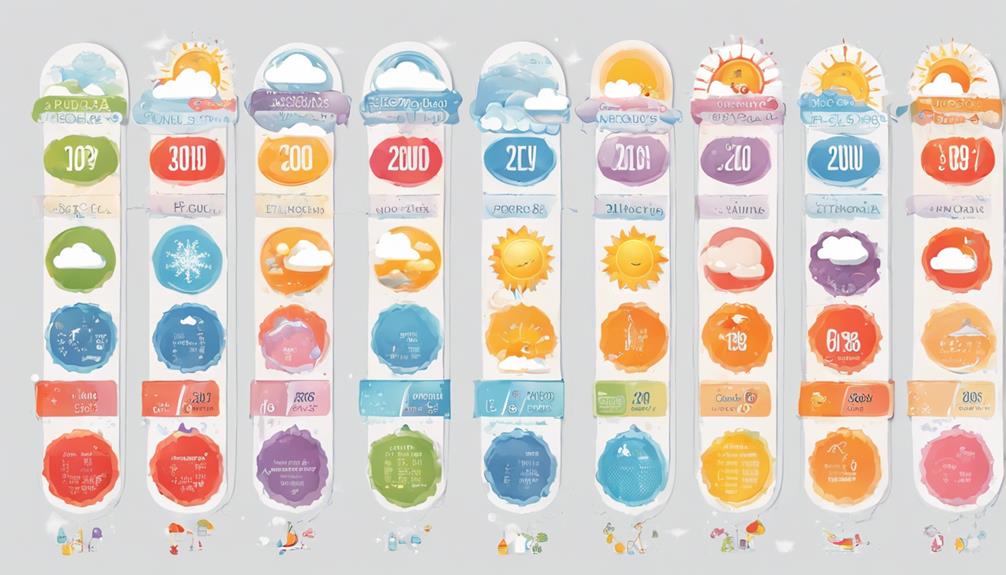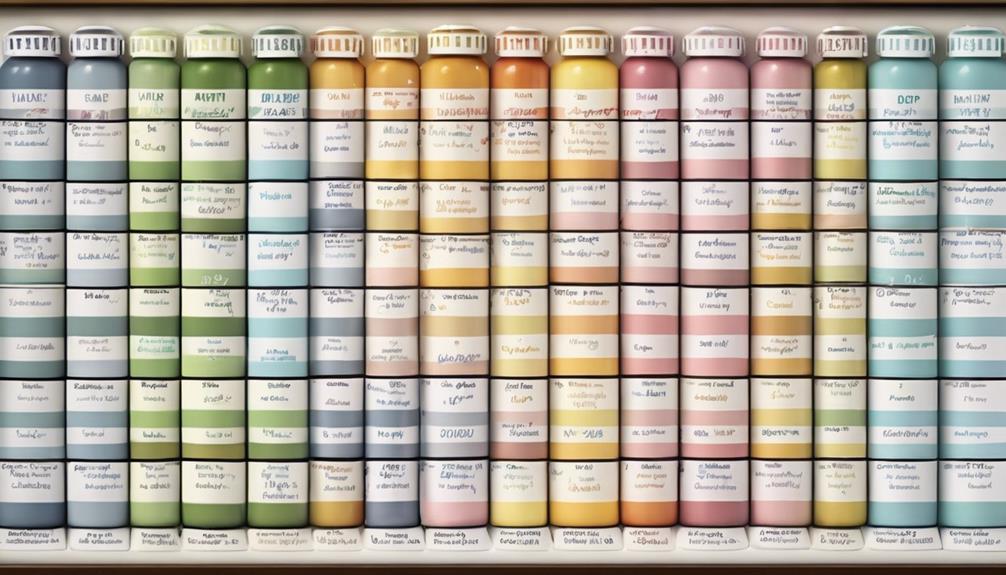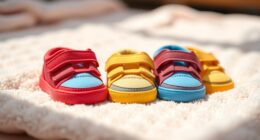When choosing clothes for your baby, it’s important to learn how to adjust their attire based on changes in the weather. Layering, choosing the appropriate fabrics, and knowing TOG ratings are essential in keeping your little one warm and cozy.
But what about those unexpected shifts in weather or indoor climates? Stay tuned as we explore practical tips and strategies for dressing your baby in response to changing temperatures, offering you a complete guide to navigate this essential aspect of infant care.
Key Takeaways
- Layer clothing appropriately for temperature regulation
- Choose breathable fabrics like cotton and wool
- Use sleep sacks or swaddles for nighttime warmth
- Consider weather conditions for outdoor dressing
Dressing Guidelines for Cooler Temperatures
When dressing your baby for cooler temperatures below 65°F, it's essential to layer their clothing appropriately to guarantee maximum warmth and comfort.
Start with a long-sleeved onesie as a comfortable base layer, then add pants, a warm sweater, hat, socks, and mittens for extra warmth. Layering not only provides warmth but also allows you to adjust your little one's clothing as needed throughout the day to maintain a comfortable temperature.
Consider using a Woolino sleep sack and footie pajamas for nighttime coziness in colder weather, making sure your baby stays snug and warm all night long. Remember to remove bulky clothing layers before placing your baby in a car seat to ensure a proper fit and best safety.
Dressing Guidelines for Warmer Temperatures
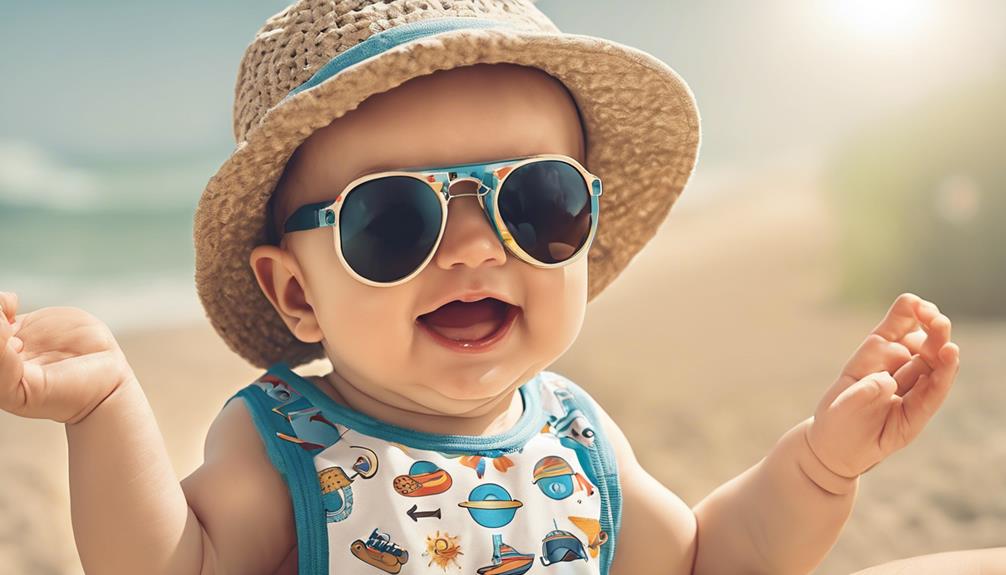
To keep your baby comfortable in warmer temperatures (65°F and above), make sure to opt for light, breathable clothing such as a onesie made from materials like bamboo or cotton. These fabrics are great for regulating body temperature and preventing overheating. Additionally, consider the following summer dressing guidelines:
- Choose Cooling Materials: Look for clothing made from breathable fabrics like cotton or bamboo to help wick away moisture and keep your baby cool.
- UV Protection: Make certain your baby's delicate skin is shielded from the sun by using a sun hat with UV protection. This will help protect their head and face from harmful UV rays.
- Stay in the Shade: When outdoors, try to stay in shaded areas as much as possible to prevent overheating and reduce sun exposure. This will help keep your baby comfortable and safe in the summer heat.
Daytime Dressing Tips for Babies
Start your baby's daytime dressing routine by layering a comfortable onesie as the base for their outfit. Add soft pants or leggings to provide extra warmth and mobility during the day. Including a cozy sweater or jacket will keep your little one snug and cozy while you're out and about. Remember to dress your baby in socks to keep their feet warm and protected, and don't forget a hat to cover their head and make sure they stay comfortable in varying temperatures throughout the day.
| Item | Description | Recommendation |
|---|---|---|
| Base Layer | Comfortable onesie | Essential for all outfits |
| Pants/Leggings | Soft and warm | Adds an extra layer of warmth |
| Sweater/Jacket | Cozy and snug | Perfect for cooler days |
| Socks | Keep feet warm and protected | Important for foot comfort |
| Hat | Covers head and regulates temperature | Ideal for varying weather conditions |
Nighttime Clothing Recommendations for Infants
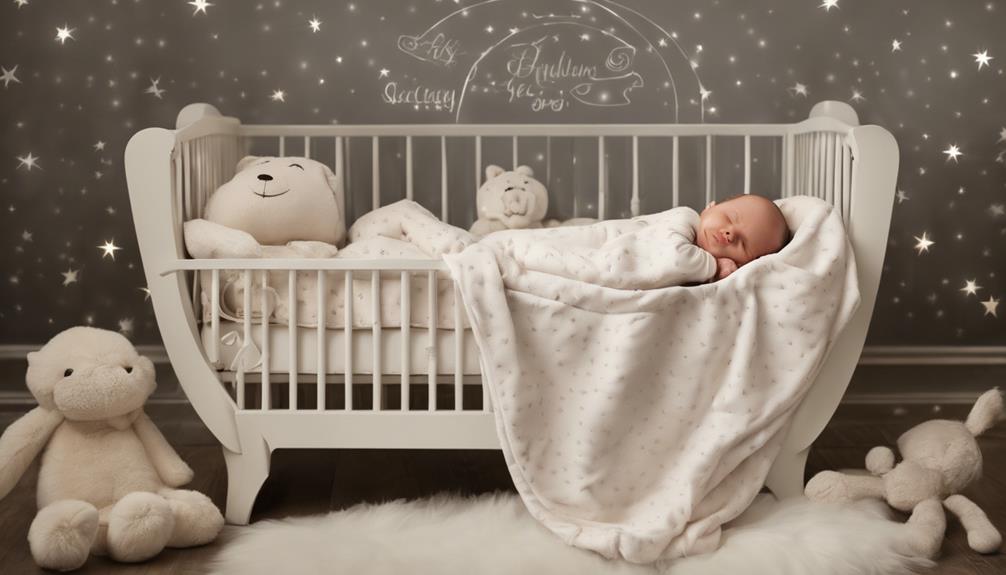
For best comfort and warmth during nighttime, dressing your infant in footie pajamas is recommended. When the temperature drops, it's important to make sure your baby stays cozy and safe throughout the night. Here are some nighttime clothing recommendations for infants:
- Use a Swaddle: Swaddling your baby can help them feel secure and mimic the cozy environment of the womb. It can also prevent the startle reflex from waking them up, promoting better sleep.
- Consider a Sleep Sack: A sleep sack is a safe alternative to loose blankets in the crib. It provides warmth without the risk of suffocation, making it ideal for cooler nights.
- Check the TOG Rating: Make sure to choose the right TOG-rated sleepwear for your baby's room temperature. A TOG of 0.5-1.0 is suitable for warmer nights, while a TOG of 2.5-3.5 is better for colder environments.
Dressing Babies for Outdoor Weather
When dressing your baby for outdoor weather, consider the current temperature to make certain they're appropriately dressed for comfort and protection. In cold weather, make sure your baby is dressed in layers. Start with a breathable base layer, add a warm middle layer like a sweater or fleece jacket, and top it off with a water-resistant outer layer. Don't forget a hat, mittens, and socks to keep their head, hands, and feet warm. If it's exceptionally cold, consider an additional layer, like a snowsuit, to provide extra insulation.
Conversely, in hot weather, dress your baby in lightweight, breathable clothing to prevent overheating. Avoid overdressing to help regulate their body temperature. Remember that babies lose heat more quickly than adults, so be cautious with the use of blankets or extra layers in warmer temperatures. When using a car seat, make sure your baby is dressed in thin layers to avoid overheating and securely fasten the harness over their clothing. Be mindful of temperature changes throughout the day and adjust their clothing accordingly to keep them comfortable and protected.
Frequently Asked Questions
What Should a Baby Wear for a Temperature Chart?
For varied temperatures, dress your baby appropriately. Choose layers like onesies, pants, sweaters, and hats for cooler days under 65°F. Opt for lighter outfits above 65°F. At night, guarantee comfort with footie pajamas or sleep sacks.
How Should I Dress My Baby for Certain Temps?
Dress your baby appropriately for different temperatures by layering clothes like long-sleeved onesies, pants, and hats for cooler days. For warmer weather, opt for light, breathable onesies and hats. Keep them comfy with footie pajamas and a sleep sack at night.
How Should I Dress My Baby at 70 Degrees?
At 70 degrees, dress your baby in a light, breathable onesie. Add comfy pants or shorts for warmth. Shield their head with a UV hat. Avoid overheating by not overdressing. Watch for discomfort signs and adjust layers as needed for comfort.
What Should a Baby With a Temperature Wear?
Keep your baby comfortable by dressing them in light clothing if they have a high temperature. Opt for breathable fabrics like cotton onesies and shorts. Monitor their temperature and adjust clothing layers accordingly for their well-being.
Conclusion
To sum up, mastering the art of dressing your baby according to the temperature is key to ensuring their comfort and safety.
By following the tips and tricks outlined in the Baby Clothes Temperature Chart, you can confidently navigate the changing weather conditions with ease.
Remember, layering with the right materials and keeping an eye on TOG ratings will help your little one stay snug and stylish all year round.
So, stay savvy, stay stylish, and stay comfortable!
